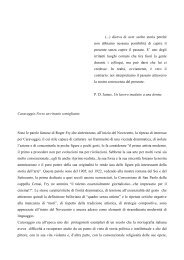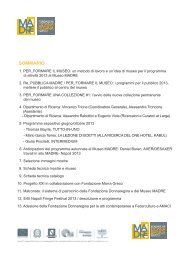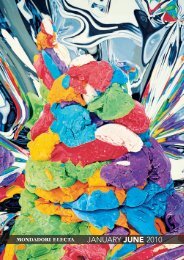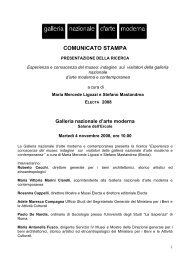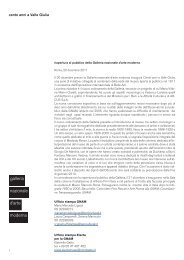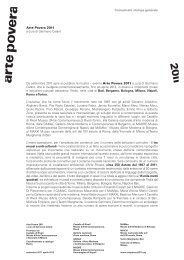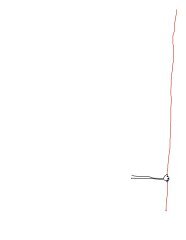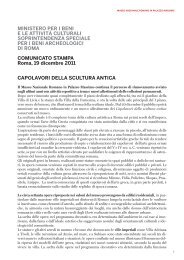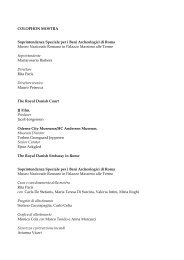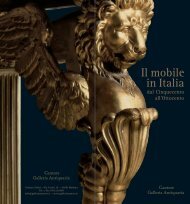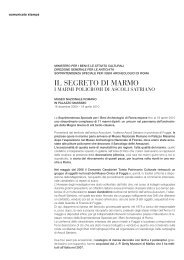Create successful ePaper yourself
Turn your PDF publications into a flip-book with our unique Google optimized e-Paper software.
La statua virile acefala, in nudità eroica, raffigura<br />
presumibilmente un principe giulio claudio, coperto<br />
sui fianchi da un corto panneggio. La statua è stata<br />
rinvenuta di recente sotto gli Orti Farnesiani *,<br />
durante lo scavo di un corridoio collegato al braccio<br />
occidentale del criptoportico tiberiano; realizzata in<br />
marmo pario, è costituita da più parti (almeno 12)<br />
assemblate insieme con perni di ferro.<br />
La superficie lapidea presenta resti di colorazione: in<br />
corrispondenza del bordo del panneggio, è presente<br />
una fascia di colore rosa, con doppio bordo di colore<br />
azzurro forse con tracce di lamina metallica; anche<br />
sul tronco (posizionato come sostegno, dietro la<br />
gamba sinistra della figura) e sulla base è presente<br />
del colore rosso. Vista la particolarità della<br />
lavorazione, la statua è stata sottoposta a una serie<br />
di analisi: attraverso la fluorescenza a raggi X,<br />
l’esame al microscopio, l’analisi microstratigrafica,<br />
e la spettrofotometria FTIR, sono stati identificati i<br />
pigmenti blu egiziano, ovverosia cuprorivaite, rosso<br />
a base di ferro, forse addizionato con minio; rosa<br />
corrispondente al purpurissum delle fonti antiche,<br />
(un colore piuttosto costoso ottenuto artificialmente<br />
in diverse maniere, in questo caso si ipotizza che<br />
possa trattarsi di un colorante vegetale: quella<br />
che oggi chiamiamo lacca di garanza (estratto<br />
dalla radice della robia tinctorum) precipitato su<br />
composto minerale). Le analisi mineralogichepetrografiche,<br />
associate ad analisi geochimiche,<br />
hanno confermato come marmo dell’isola di Paros le<br />
due parti maggiori costituenti la statua.<br />
Infine è stata effettuata una radiografia a raggi<br />
X per ottenere informazioni più precise circa il<br />
posizionamento e la tenuta dei perni.<br />
U N A N U OVA S C O P E RTA<br />
DAG L I S C AV I D E L L A<br />
D O M U S T I B E R I A N A<br />
A N E W F I N D I N G<br />
F RO M T H E E X C AVAT I O N S<br />
O F T H E D O M U S T I B E R I A N A<br />
The headless male statue, a heroic nude, his sides<br />
covered by a short cloak, presumably depicts a Julio-<br />
Claudian prince. The statue was found recently<br />
beneath the Farnese Gardens, during the excavation<br />
of a corridor linking to the western wing of the<br />
Tiberian cryptoporticus. Made of Parian marble, it<br />
is formed of many pieces (at least 12) held together<br />
with iron clamps.<br />
The stone surface retains traces of colouring. A<br />
strip of red, with a double border of blue with<br />
possible traces of metallic foil, can be seen at the<br />
border of the cloak. A red colour is also present<br />
on the throne (positioned as a support, behind<br />
the figure’s left leg) and on the base. Because of<br />
its distinctive manufacture, the statue underwent<br />
a series of analyses, such as X-ray fluorescence,<br />
microscopic examination, microstratigraphic<br />
analysis, and FTIR spectrophotometry. These<br />
identified additional pigments; ‘Egyptian<br />
blue’ or cuprorivaite; iron-based red, perhaps<br />
supplemented with minium (lead tetroxide);<br />
and pink that corresponds to the purpurissum<br />
described in the ancient sources. This was a<br />
rather expensive colour, obtained artificially in<br />
a number of ways. In this case it is thought to<br />
derive from a vegetal source, known today as<br />
Rubia lacquer, extracted from the root of the robia<br />
tinctorum, precipitated onto a mineral compound.<br />
Mineralogical-petrographic analysis, along with<br />
geochemical analysis, has confirmed that the<br />
marble forming the two main parts of the statue is<br />
from the island of Paros. Finally, X-ray radiography<br />
was undertaken to obtain more precise information<br />
about the placement and fastening of the clamps.<br />
38 CRIPTOPORTICO NERONIANO



